OQO model 01+ Tablet Edition Review
OQO model 01+ Tablet Edition
Intel may be making a fuss over the Ultra Mobile PC, but OQO has been there and done that.
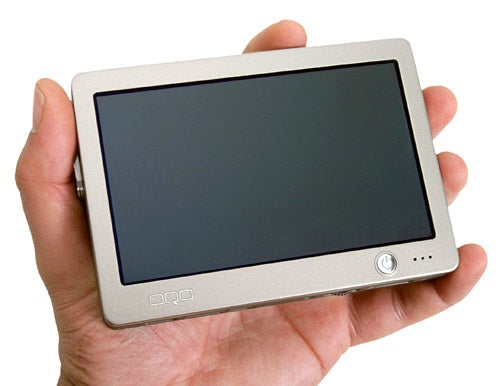
Verdict
Key Specifications
- Review Price: £1870.00
With all of the fuss surrounding Microsoft’s Origami launch at CEBIT and Intel’s more recent UMPC (ultra mobile PC) announcements you’d be forgiven for thinking that making PCs really small was a revolutionary new concept. What a great idea – cramming all of the functionality of a desktop PC into an easily portable package. Why hadn’t anyone thought of that before?

Of course nothing could be further from the truth. Computer manufacturers have been striving to build the smallest machines imaginable ever since the first ‘portable’ home computer gave its unfortunate owner a hernia trying to lug it from desk to boot of car.
Way back in the late Nineties Toshiba with its Libretto released the tiniest laptop the industry had ever seen – and it’s still not far off being that now with the firm has reviving the range. And over a year before Microsoft and Intel started to get the mainstream press over-excited OQO was quietly developing a UMPC all of its own.
In early 2005 OQO launched its model 1 – probably the smallest (and sexiest) machine yet to run full-blown Windows. It was little larger than a standard PDA, had the sort of build quality you’d be more likely to associate with military hardware, and it had the coolest sliding screen which smoothly rolled back on a rack-and pinion-system to reveal a full blown QWERTY keyboard, complete with number pad, underneath.
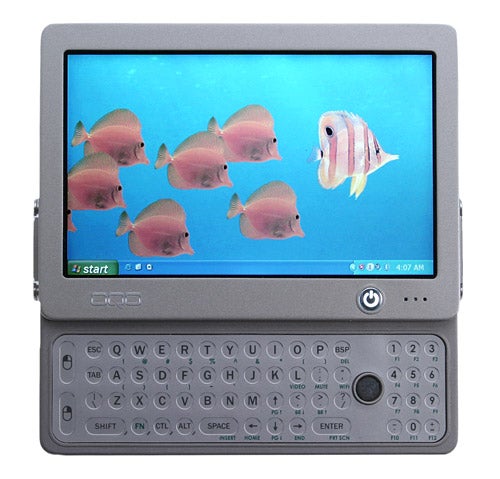
Riyad first laid eyes on the diminutive OQO model 1 at CES back at the beginning of last year and reviewed the company’s groundbreaking pocket machine in the summer (you can read the full review here). He loved it and since then we at TrustedReviews have been following its fortunes closely. Just recently it has undergone some dramatic changes so we thought it was worth revisiting.
The biggest change is that the OQO 01+ Tablet Edition now comes with – you guessed it – Windows Tablet PC installed instead of plain old Windows XP Professional. This means you get extras such as handwriting recognition, e-ink and Windows Journal on top of all the features of Windows XP Professional. It seems a perfect fit. After all if you don’t get on with the keyboard and stick pointer under the screen – and if you’ve got chunky or just plain clumsy fingers we can see how that might be the case – you’ve got another way of navigating and entering text.
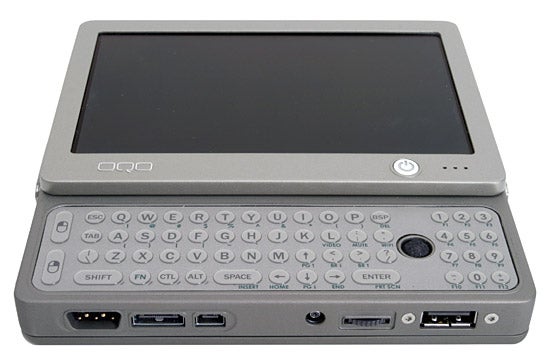
The big question is does it really make the OQO any easier to use? After all the tiny keyboard under the screen is quite usable once you get used to it and the trackpoint with its left and right buttons, which fall handily under your left thumb, works quite well too. Unfortunately the Tablet PC features don’t really add that much; in fact I found writing in the on-screen handwriting recognition pane more fiddly. It’s the small size of the screen that’s the problem. Although the resolution (800 x 480) is good enough to make most standard Windows jobs manageable – even web browsing isn’t too much of a pain – the small size (just 5in in diagonal) means there’s nothing to lean your hand against when writing notes, for instance, and you quickly run out of room on the handwriting recognition pane.
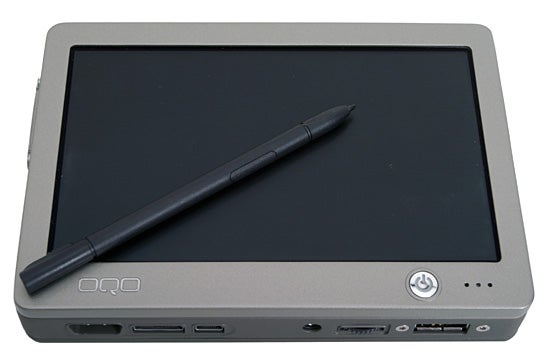
Fortunately, the other changes are much more effective upgrades. There’s nothing new about the heartbeat of the machine. All the horsepower is still provided by a 1GHz Transmeta Crusoe processor. Not the speediest CPU on the planet but a good choice where low power drain is a priority – I managed to get around three hours of use out of the removable lithium polymer battery. What is new is that the USB connection has been upgraded from a disappointing and sluggish 11Mbits/sec 1.1 to the much more zippy version 2.0, and the 20GB shock-protected hard disk has been upped to 30GB.
All of this makes the OQO even more versatile than before. The speedier USB interface now means it’s actually practical to use as interim storage for your digital pictures, while transferring large files such as PowerPoint presentations to and from the machine using a USB thumb drive is also more workable than before. And with that extra hard disk capacity you can really go to town downloading and installing all of the software you really love to use on your desktop machine.
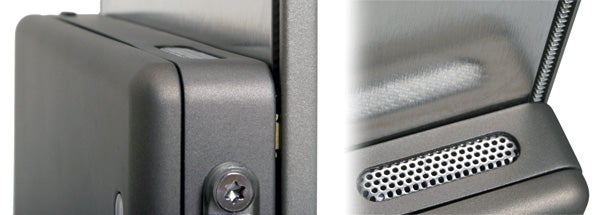
And of course it still boasts all of the features that made it so attractive in the first place. At slightly larger than the average PDA it’s still the only truly pocketable machine to run full-blown Windows XP. It can still be used either PDA-style typing away with your thumbs or as a mobile replacement for your desktop PC – its ingenious docking cable, which crams Ethernet, FireWire, USB, VGA, 3.5mm headphone and power sockets into one knobbly length of flex, is a surprisingly elegant alternative to a proper docking cradle. And there’s still no other device this small that allows you to create and present PowerPoint slides, then display those slides in their full glory on a 1280 x 1024 resolution external monitor.
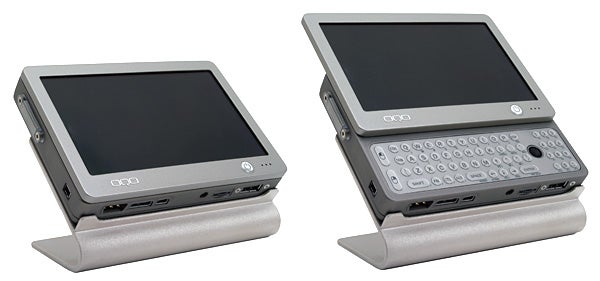
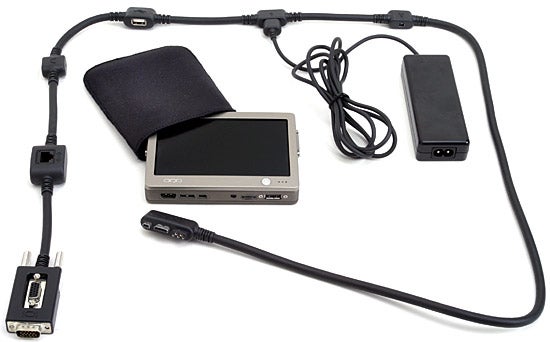
Of course you don’t have to use the docking cable to stay connected with the OQO. There’s also a wireless network adapter built in (though of the slower 802.11b variety), Bluetooth for those who become frustrated with the tiny keys on the built-in keyboard, plus USB and FireWire ports (amazingly) squeezed in around the edges the chassis itself.
In fact the only disappointment is that a little more grunt hasn’t been made available this time around. The 1GHz Crusoe processor and 512MB of RAM cope fine if you stick to one job at a time, but if you try to run too many applications at once and start to flick between them you’ll notice significant slowdown – that said, the memory complement is a big improvement on the 256MB seen in the original model 01. And don’t let the ‘3D accelerated graphics’ claim fool you either – this is definitely not a gaming machine. But given the many advantages of being able to stick your work PC in your back pocket instead of having to lug it around in an armoured laptop case, it’s a compromise that many will be prepared to make.

”’Verdict”’
And that really is the story here. The OQO model 01+, like its predecessor, is a story of compromises. This one is slightly more usable and flexible, admittedly, but the bigger considerations still remain. It’s great that the USB connection is now faster, and the extra 10GB of hard disk space is a plus too. Likewise the increased memory is also a welcome bonus, but Tablet PC Edition doesn’t actually add that much in terms of on-the-move practicality because the small size of the device makes it fiddly to use.
Neither is the OQO as practical as a standard laptop. The keyboard, though usable, restricts the speed at which you can work, you have to be prepared to sacrifice response times and performance too. It isn’t cheap either at a whopping £1,869.95 with Office thrown in.
But I reckon for something this well-designed and engineered that the compromises are worth making. A fully-featured PC that fits in your pocket? I’d love one, thanks.
(table:features)
How we test laptops
Unlike other sites, we test every laptop we review thoroughly over an extended period of time. We use industry standard tests to compare features properly. We’ll always tell you what we find. We never, ever, accept money to review a product.
Trusted Score
Score in detail
-
Value 6
-
Features 10

